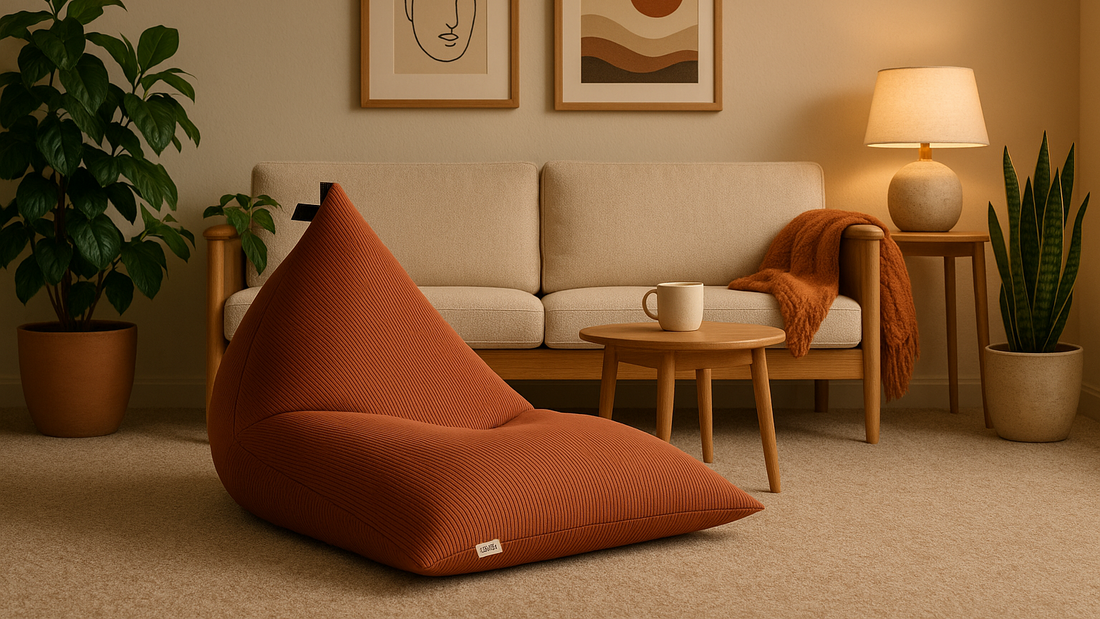
Bean Bag Chairs: Bad for Your Posture? Or a Secret Fitness Hack?
Let’s Talk Posture, Myths, and Movement
"Bean bag chairs are bad for your posture." We hear it all the time. But let’s pause for a second. Is it really that simple? Or have we misunderstood what movement, comfort, and health look like in the modern living space?
This blog isn’t just about defending bean bag chairs. It’s about challenging the one-size-fits-all take on posture, highlighting a hidden benefit of these humble, squishy seats, and redefining how we see furniture in the first place.
Spoiler alert: bean bag chairs might be doing more for your body than you think.
Rethinking "Good Posture"
Posture isn’t a fixed thing. It’s dynamic. Your body isn’t meant to hold a rigid 90-degree angle for hours. In fact, being too static for too long—whether in a fancy ergonomic chair or on the floor—can wear your body down.
Bean bag chairs, on the other hand, encourage movement. You shift. You adjust. You sink in, slide out, and twist around. It’s casual, but it’s also closer to how our bodies were designed to move: freely and without stiff restrictions.
Squats Without the Gym
Here’s where things get interesting.
Every time you get up from a bean bag chair, you’re doing a full-body move that mimics a perfect squat. Think about it:
- You’re engaging your core.
- You’re using your glutes, quads, and hamstrings.
- You’re lifting your own body weight, not a machine-assisted load.
Most people half-fake squats at the gym. On a bean bag, you're doing the real deal—naturally, without overthinking it. That’s functional fitness in action. Multiply that by how often you plop down and get up throughout the day, and it adds up.
But What About Back Support?
Let’s be honest: not all bean bag chairs are created equal.
Some are floppy. Some deflate fast. And yes, some don’t give your back the love it deserves. That’s where design comes in. The bean bag chairs we craft are built with support in mind. Not stiff support—adaptive support. They mold to your body, cradling you instead of forcing you into an unnatural posture.
Plus, you’re not supposed to sit in one spot forever. Stand up. Stretch. Sink back in. That rhythm? It’s healthier than locking yourself into an ultra-structured chair for 8 hours straight.
Movement Is Medicine
Humans weren’t meant to sit still. Whether you’re lounging on a bean bag chair while reading, watching something, or catching up on calls, your body is constantly micro-adjusting. That low-level motion stimulates your muscles, improves circulation, and prevents stiffness.
Compare that to a stiff office chair where your spine and hips are locked in. Which one sounds more natural?
Designed for Chill. Engineered for Real Life.
We don’t just make bean bag chairs. We make soft spots for your life to happen.
- Low and grounded: They bring your body closer to the earth—a posture many cultures embrace.
- Handles and lightweight builds: Make moving them part of your flow.
- Durable, comfortable materials: No sagging, no fluff-collapse.
We’ve seen our bean bag chairs become more than seats. They're reading nooks. Meditation spots. Home office zones. Even post-workout chill pods. And each time someone gets up from one, they’re unknowingly giving their lower body a little strength boost.
Are They for Everyone?
If you have specific back issues or mobility concerns, always listen to your body (and your doctor). But for most people, introducing a bean bag chair into your home isn't just a comfort upgrade—it’s an invitation to move differently.
To relax more intuitively. To embrace rest and movement. To make your everyday space a little more flexible.
The Bottom Line
Bean bag chairs have long been underestimated. Seen as casual, childish, or bad for posture. But what if we told you they were actually:
- Encouraging natural movement?
- Helping you sneak in bodyweight squats?
- Supporting dynamic posture instead of rigid alignment?
- Sparking moments of mindfulness and reset in your day?
It’s time to upgrade the narrative.
Bean bag chairs don’t just support your chill. They support you.
Maybe they’re not bad for your back… maybe they’re just good for your glutes.
